Milan, from 24 February to 17 March 1967.
The Establishment hinders the distribution of the magazine Mondo Beat and the Mondo Beat Movement confronts the Establishment: it is the baptism of fire of the Contestation.
On 24 February 1967 Tecnografica Milanese delivered the 4,000 copies of the new issue of Mondo Beat magazine (the pages of which were reproduced in the previous chapter).
Although decimated by the police, Mondo Beat had youths enough for distributing the magazine on the streets of Milan, youths who could not be ordered to leave Milan as they lived in the city and in the suburbs. Thus, on the morning of February 25, boys and girls lined up in the Cave, each to take one hundred copies of Mondo Beat, fifty copies of the newly published issue and fifty of the remaining copies of the previous one. Melchiorre Gerbino also went to sell, to observe people's reactions. People bought, some with a complicit attitude, some with some critical movement of the head, but they bought because Mondo Beat was famous for the many young people who ran away from home to join the Movement. Melchiorre Gerbino sold his hundred copies in two hours, which was not exceptional, given that almost any seller would have done the same. Since the price of the copy was 100 Lire, of which 25 for the seller, a seller would have earned 2,500 Lire after two hours of selling, a considerable sum, considering that a complete meal, including wine, cost 400 Lire in ordinary restaurants.
Between February 25th and 26th we sold 3,000 copies of the last issue and 3,000 of the previous one. A resounding success. And we experienced hours of joy in the Cave. But they wouldn't have lasted long, as from February 27 the traffic police would have chased us and asked for a street vendor's license, failing which they would have seized the copies and imposed a fine of 18,000 Lire for "violation of Law 121 on public safety".
At that, Melchiorre Gerbino and Umberto Tiboni blocked the sale and consulted on what to do. To cope with the ongoing situation, they decided to take on the functions for which Vittorio Di Russo had been responsible. Thus, Umberto Tiboni would have maintained the contacts between Mondo Beat and the other extra-parliamentary groups, while Melchiorre Gerbino would have placed himself at the head of the Movement's public demonstrations. In this new role, Melchiorre Gerbino addressed the young people who crowded the Cave and proposed a three-day hunger strike, to attract the public's attention, then a demonstration to paralyze traffic in the center of Milan, in the evening hours peak time on a working day. These proposals having been unanimously accepted, messengers were sent to Genoa, Turin, Padua, Venice, Trento, Bologna, Florence, Rome... to ask the young people of Mondo Beat to gather in Milan.
Mondo Beat Hunger Strike. Milan, 4-7 March 1967.
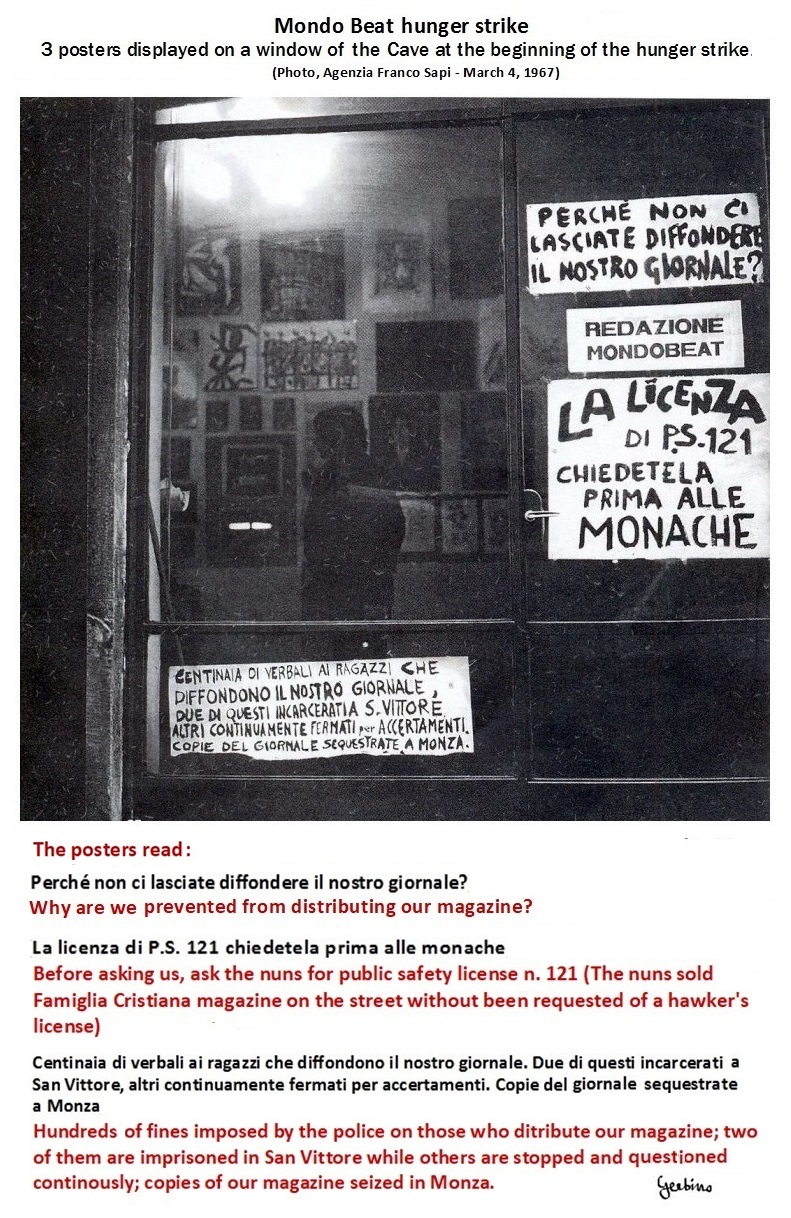
Three posters displayed in a window of the Cave
PERCHÉ NON CI LASCIATE DIFFONDERE IL NOSTRO GIORNALE?
Why won't you let us spread our magazine?
LA LICENZA DI P.S. N. 121 CHIEDETELA PRIMA ALLE MONACHE.
Before asking us, ask the nuns for public safety license no. 121. (Note that the nuns were not asked for any license to sell the magazine Famiglia Cristiana on the street).
CENTINAIA DI VERBALI AI RAGAZZI CHE DIFFONDONO IL NOSTRO GIORNALE. DUE DI QUESTI INCARCERATI A SAN VITTORE, ALTRI CONTINUAMENTE FERMATI PER ACCERTAMENTI. COPIE DEL NOSTRO GIORNALE SEQUESTRATE A MONZA.
Hundred of fines for the youths who spread our magazine. Two of them imprisoned in San Vittore, others interrogated continuously. Copies of our magazine seized in Monza.
On March 4, on the occasion of the beginning of the hunger strike, the windows of the Cave were used for the first time to display posters. Since then, this practice would have continued uninterruptedly. Although the posters were written with the ugly handwriting of Melchiorre Gerbino, they proved to be of great importance, since they were photographed and published by newspapers and magazines and seen by hundreds of thousands of people throughout Italy. In fact, the windows of the Cave would have proven to be the main factor in spreading the Contestation among the mass of people.
I will give proof of the enormous importance of the windows of the Cave in triggering the Contestation, so I will show what the newspaper L'Unità published and what would have been the consequences:
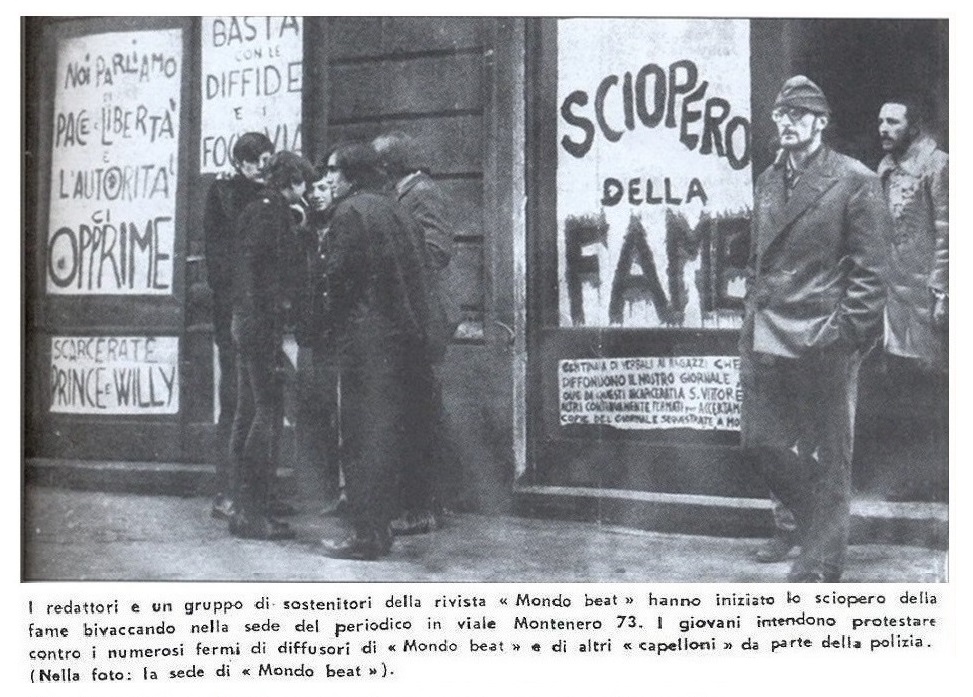
L'Unità, 6 March 1967, on Mondo Beat Hunger Strike.

Translation of what L'Unità published on March 6 on Mondo Beat hunger strike.
It should be considered that L'Unità was the official newspaper of the Italian Communist Party which, at the time, was the largest communist party in the Western world and the party with the most votes in the legislative elections in Italy. It is therefore understandable that this newspaper had circulation throughout Italy and that a photo and related legend on the Mondo Beat Hunger Strike, like this one, would have been noticed by hundreds of thousands of people.
Let us now consider that Mondo Beat Hunger Strike lasted from 4 to 7 March and this photo and the related legend appeared on the morning of the 6th, that is, when the inhabitants of Milan and the suburbs had time to come to the Cave to see the hunger strike. And now look at these two photos below
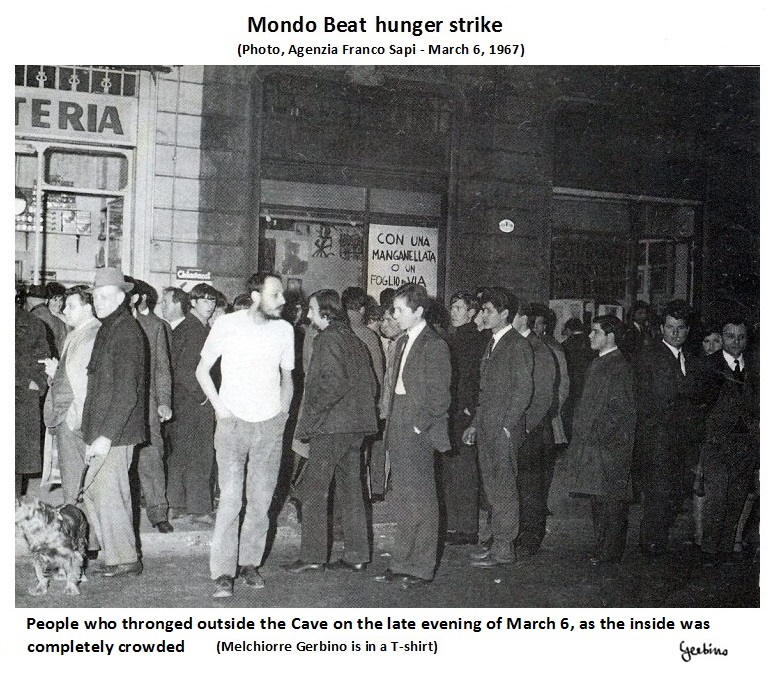
People who thronged outside the Cave on the late evening of March 6, as the inside was completely crowded.
Melchiorre Gerbino, in a T-shirt, takes a breath of fresh air outside the Cave.
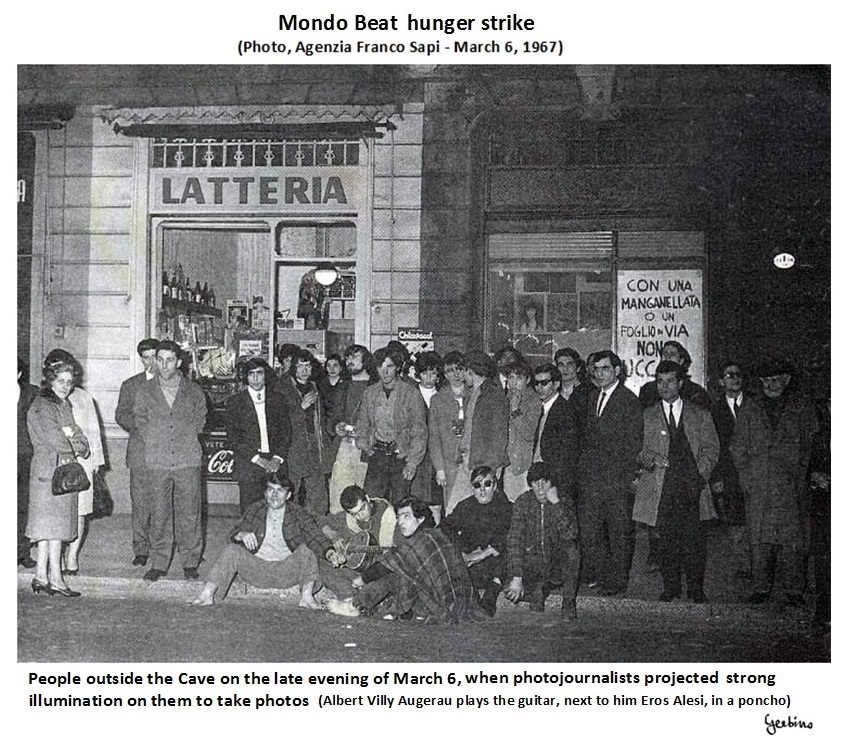
People outside the Cave late in the evening of March 6, when photojournalists shined bright lighting on them to take photos.
Sitting on the ground, Albert Willy Augerau plays the guitar and Eros Alesi Pasticca wears a poncho; behind them stand Zafferano and Cristo di Monza.
In fact, so many people arrived, who had read about the hunger strike on the newspaper L'Unità, that the Cave could not contain them all. These two photos were taken late in the evening, imagine how many persons had crowded in the afternoon, so many that traffic in Via Vicenza, the road where the Cave was located, was paralyzed and motorists had to divert onto other roads.
The windows of the Cave, in fact, would have proved decisive in triggering the mass contestation. The communist media published the posters of the Cave windows because we contestated the establishment and the communists liked this. In turn, even conservative newspapers and magazines could not help but reproduce the posters of the Cave windows, since their readers were interested in Mondo Beat, due to the many boys and girls who fled their homes and joined the Movement.
Conservative newspapers and magazines tried to give a negative image of Mondo Beat, but the more they tried the more they fell into the trap of giving resonance to the Movement. All this was unprecedented, as no one had used the windows as we did in the Cave. And it was something unprecedented not only in Italy, but everywhere, like the Contestation itself.
Some articles on Mondo Beat hunger strike
The event had resonance in the press throughout Italy, since the Mondo Beat Movement was already known everywhere. In the case of the hunger strike, people were particularly interested because among the 15 young people who fasted for 3 days and 3 nights inside the Cave, there were 6 girls, 4 of whom were teenagers, and this for those days was surprising, almost incredible.
(Various newspapers)
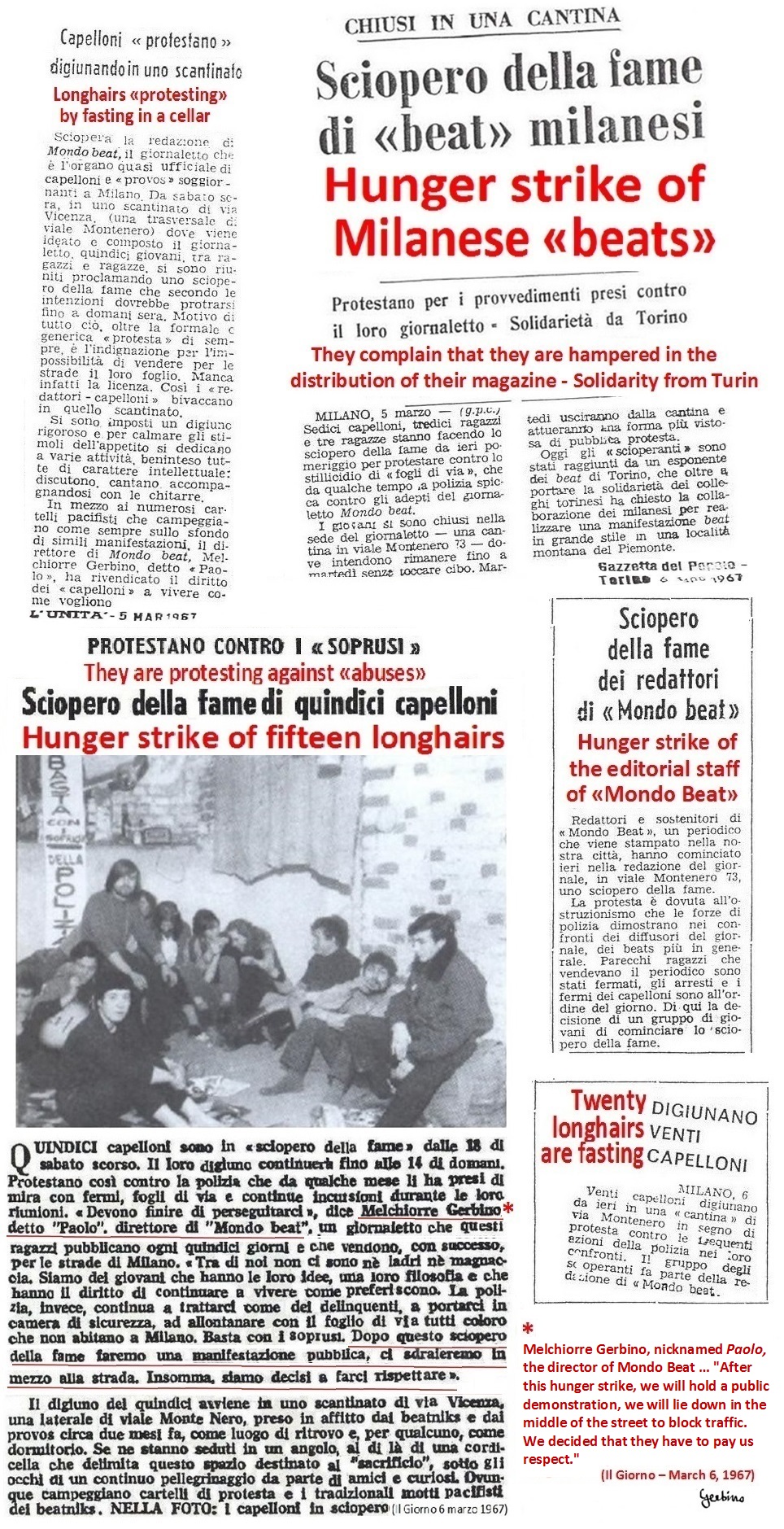
We have decided that they have to pay us respect.
(Various newspapers)

The Beats of Milan do not surrender.
(Romana Rutelli)
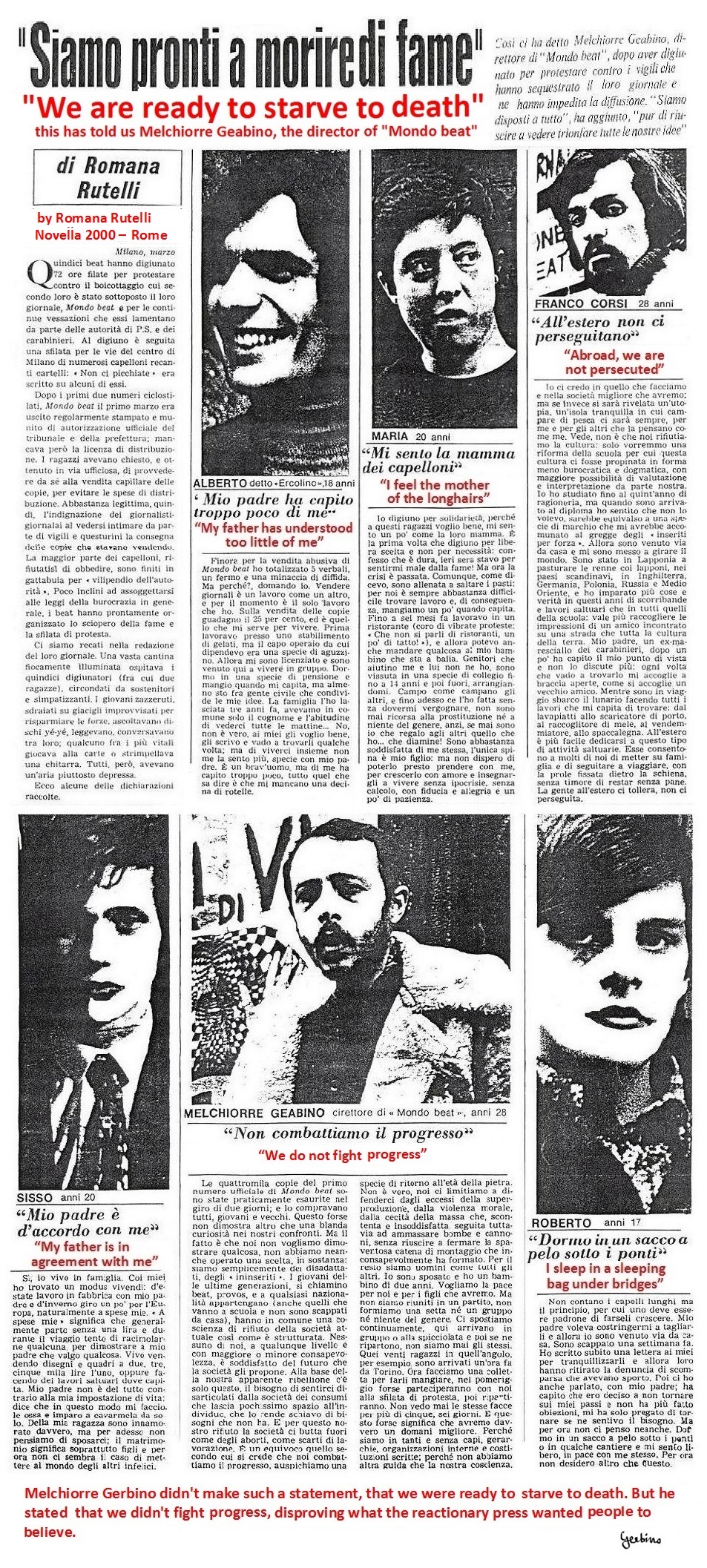
We do not fight progress. Melchiorre Gerbino made it clear that Mondo Beat did not fight progress, disproving what the reactionary press wanted people to believe.
Mondo Beat Hunger Strike and the demonstration that would follow coincided with the annual meeting of Lombard journalists, whose official organ was "Il Giornalismo". Here is an excerpt from the speech given on this occasion by Carlo De Martino, the President of the Order.
(Il Giornalismo - March 1967)
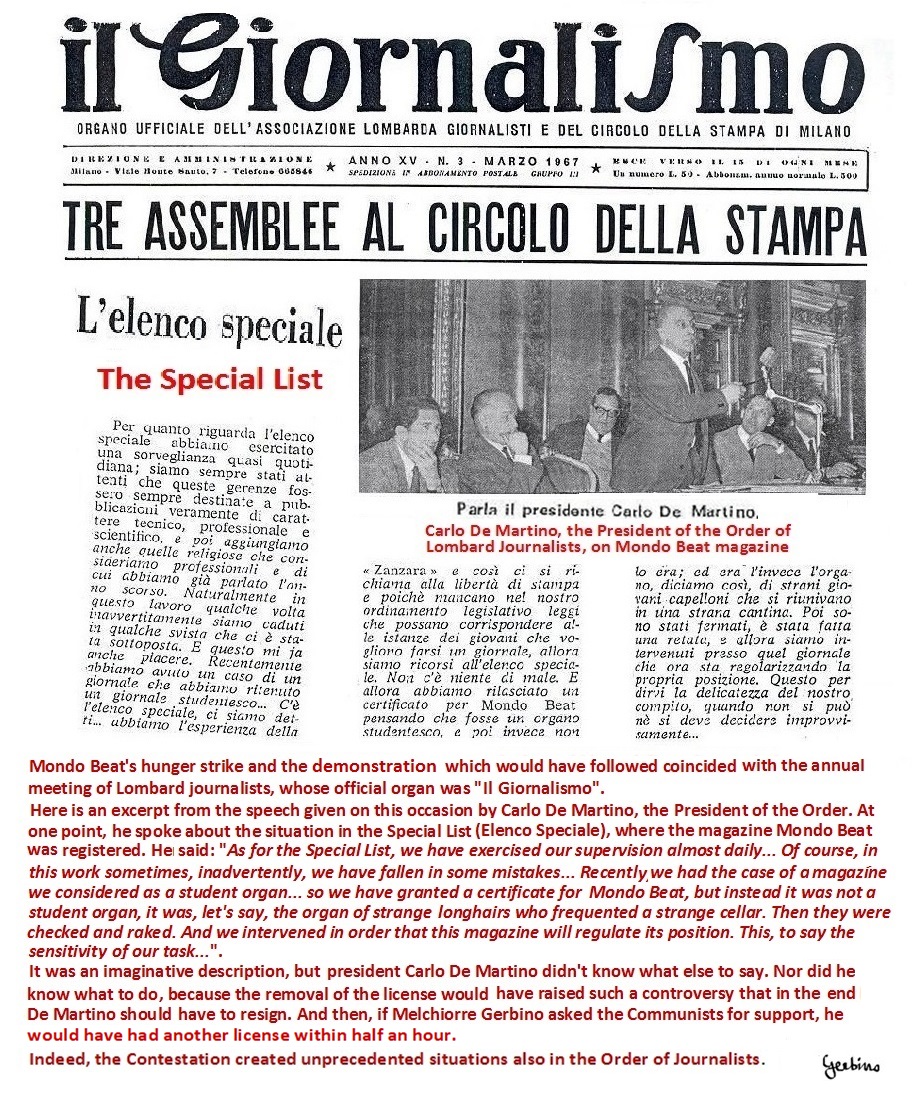
The situation created by the magazine Mondo Beat embarrassed Carlo De Martino, the president of the Order of Lombard journalists,
Carlo De Martino, at one point spoke about the situation in the Special List (Elenco Speciale), where the magazine Mondo Beat was registered. He said: "As for the Special List, we have exercised our supervision almost daily... Of course, in this work sometimes, inadvertently, we have fallen in some mistakes... Recently we had the case of a magazine we considered as an organ for students... so we have granted a certificate for Mondo Beat, but instead it was not an organ for students, it was, let's say, the organ of strange longhairs who frequented a strange cellar. Then they were checked and raked. And we intervened in order that this magazine will regulate its position. This, to say the sensitivity of our task...".
It was an imaginative description, but the poor president Carlo De Martino didn't know what else to say. Nor did he know what to do, because the revocation of the license would have raised such controversy that in the end Carlo De Martino would have had to resign. And then, if Melchiorre Gerbino had asked for the support of the communists, within half an hour he would have had another license.
Yes, the Contestation would have created unprecedented situations even in the Order of Journalists.
Some images of Mondo Beat Hunger Strike (from various publications)
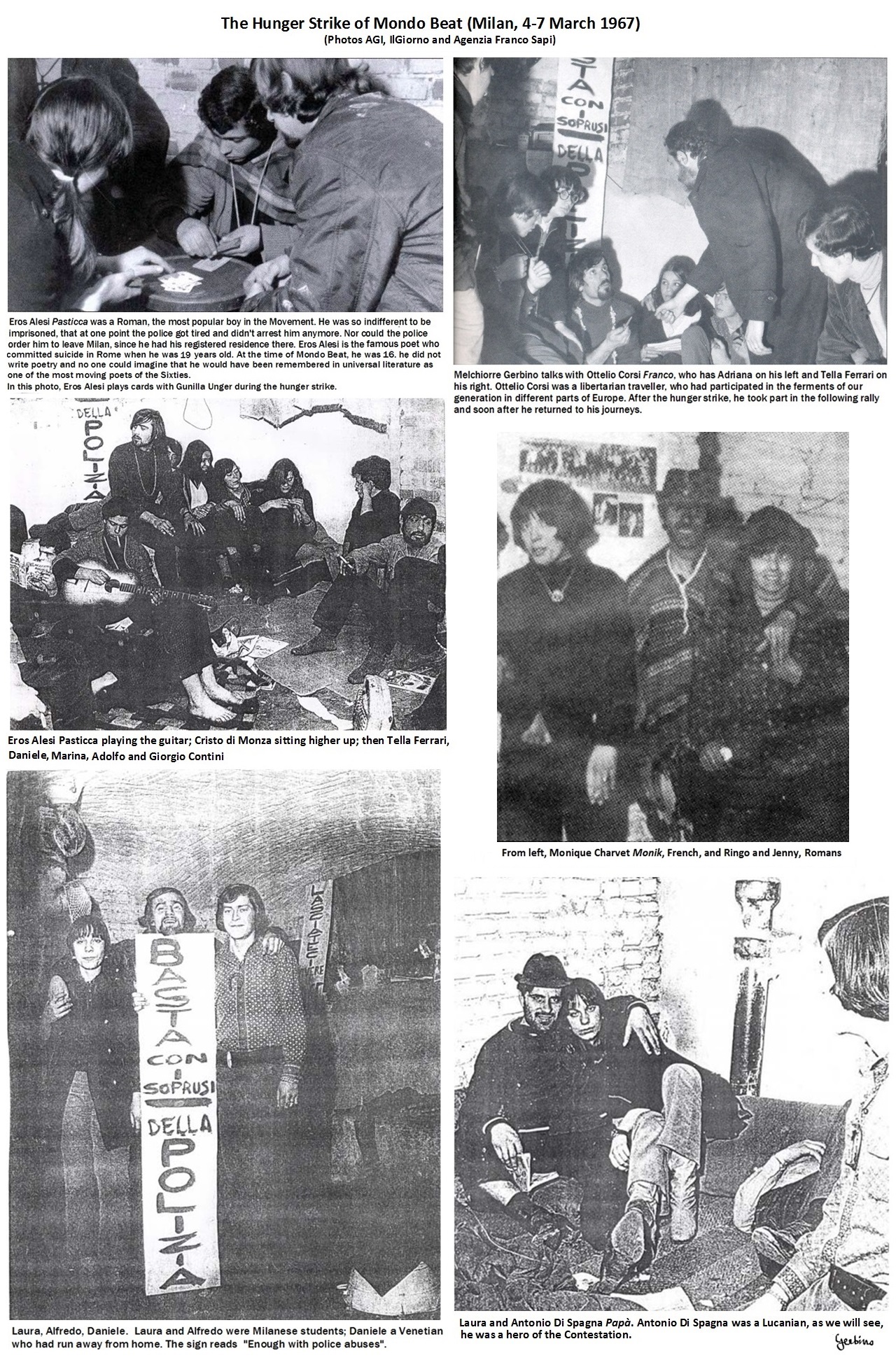
In the first photo at the top left, Eros Alesi Pasticca is portrayed playing cards with Gunilla Unger.
Eros Alesi, Roman, was the most popular boy in the Mondo Beat Movement. He was so indifferent to being incarcerated that at one point the police got tired and didn't arrest him anymore. After an overland journey to India and a deportation from India to Italy, Eros Alesi committed suicide in Rome, when he was 19 years old. At the time of Mondo Beat he was 16 years old, he did not write poetry, nor he did publish anything in Mondo Beat magazine, and no one in the Movement could imagine that he would be remembered in universal literature as one of the most moving poets of the Sixties.
In the other photos of the same collage there are other characters from the Mondo Beat Movement who took part in the hunger strike and some descriptions about them.
As for the hunger strike, it ended on March 7 at noon. On the same day the guys from Mondo Beat would arrive, coming from different cities, to participate in the demonstration, together with them there were young French, German and English people, of those who had rescued Florence after the flood.
At 4 pm the premises of the Cave were crowded with youths, then small groups of 3 or 4 of them began to come out of the Cave. Once outside, they headed in different directions, so as not to arouse the suspicions of the police officers who were usually assigned nearby. We would all meet at the Arco di Porta Venezia (Arch of Porta Venezia) at 6 pm.
Sent by Giuseppe Pinelli, a young anarchist from the Sacco and Vanzetti section, a chimney sweep named Vito, arrived with his van at the Cave and loaded the signs that we had prepared for the demonstration, to leave them at the Arco di Porta Venezia at 6 pm.
Only Umberto Tiboni and Giorgio Contini would have remained in the Cave, to keep it open, as it was a refuge, since the police could not access the Cave without a judicial warrant.
"Demonstration to Contestate the Establishment" (Manifestazione di Contestazione del Sistema) - Milan, 7 March 1967.
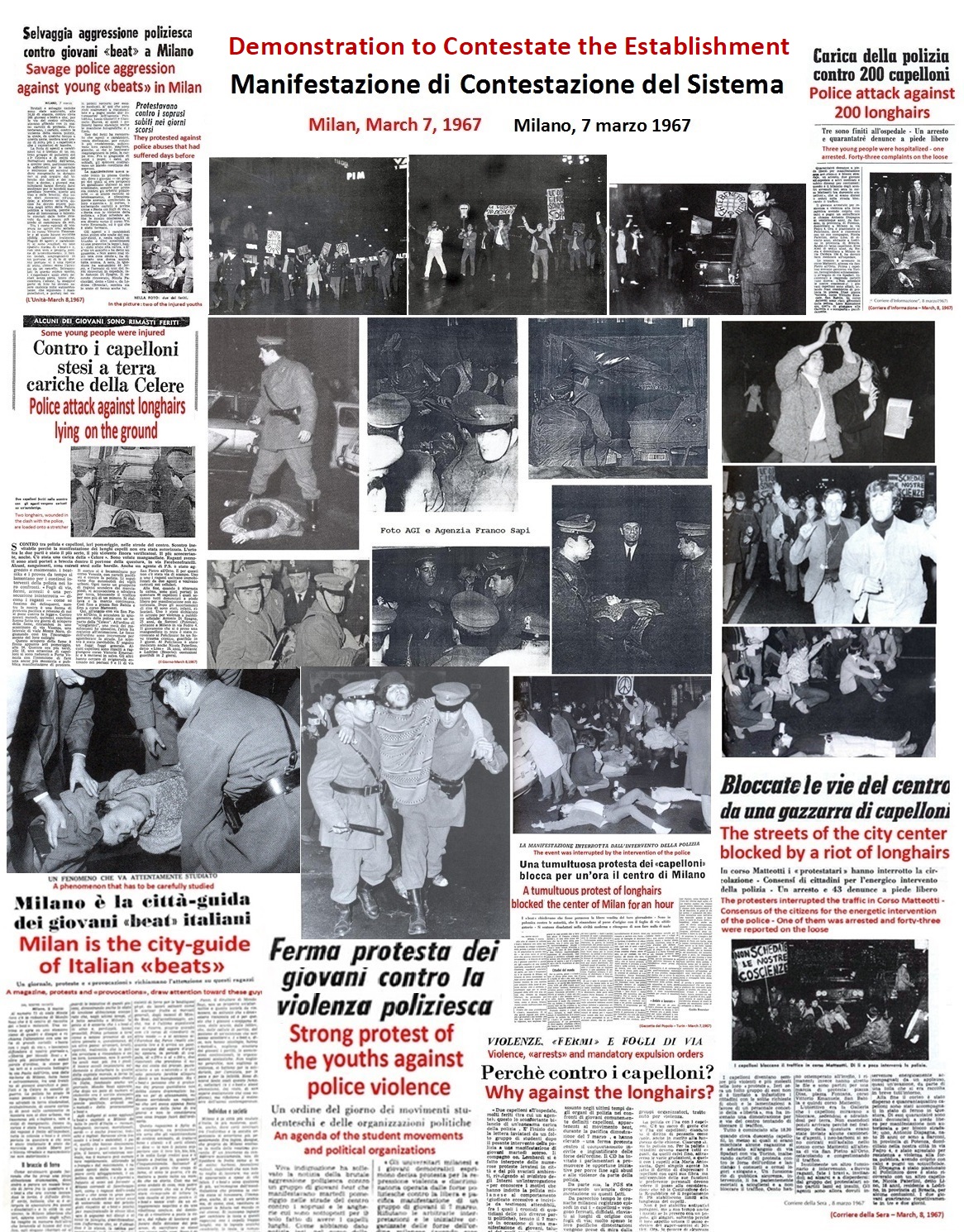
A collage of titles and photos on the Demonstration to Contestate the Establishment.
----------------
The Demonstration to Contestate the Establishment started from the Arco di Porta Venezia at 6 pm, from there it proceeded towards Piazza Duomo.
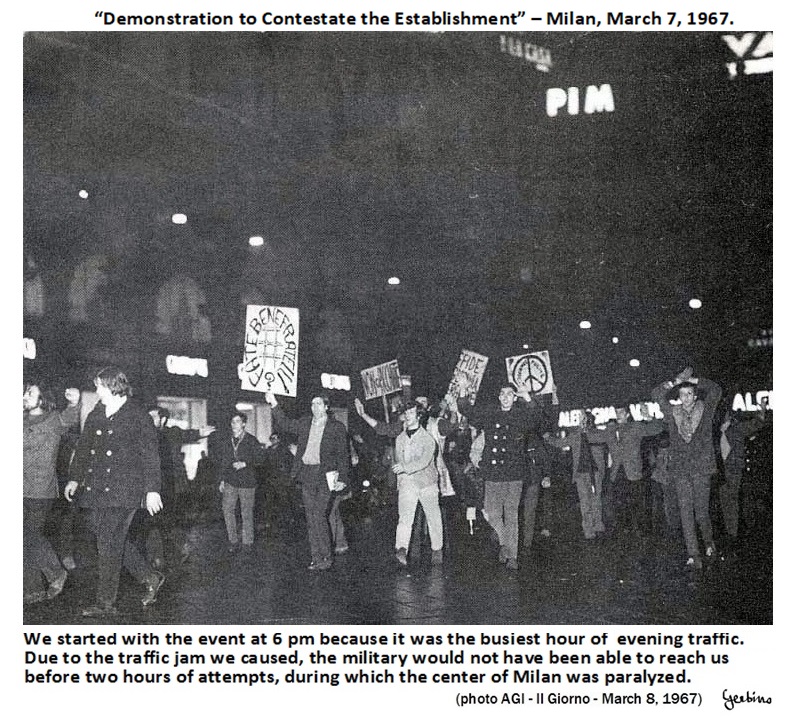
We started with the event at 6 pm as that was the busiest hour of the evening traffic. At that time it was already dark.
The senior officials of the Milan Police Headquarters, who were already at home in front of the television, would have organized the special "Celere" unit and would have reached us no earlier than two hours after the start of the demonstration, in the meantime we would have paralyzed the center of Milan.
----------------
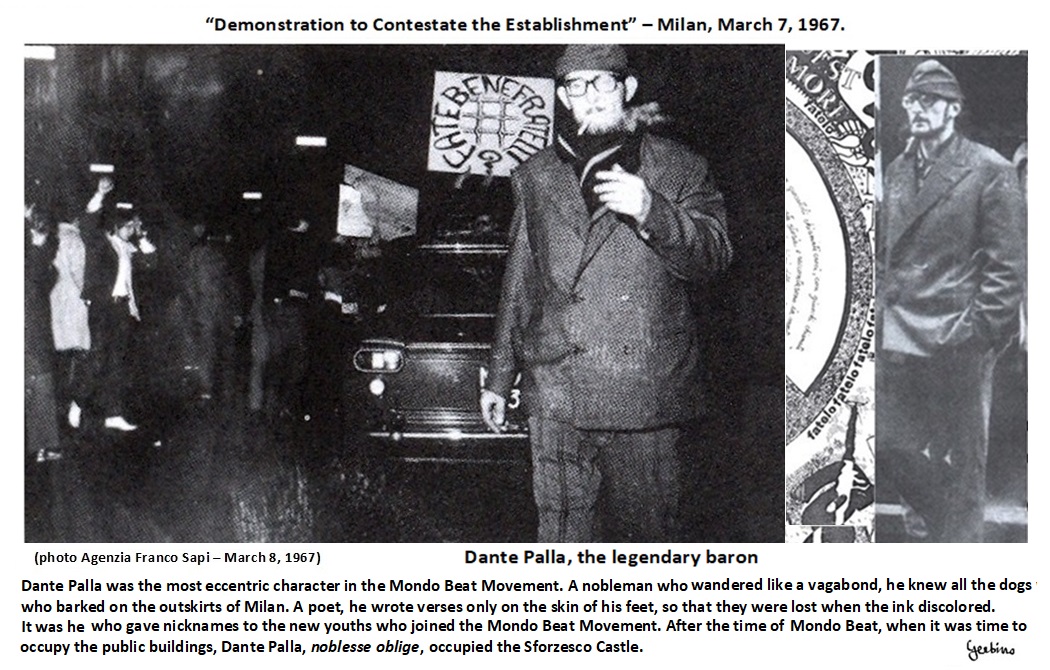
Demonstration to Contestate the Establishment - Dante Palla
Dante Palla was the most eccentric character in the Mondo Beat Movement, a nobleman who wandered like a vagabond, a poet who wrote verses only on the skin of his feet so that they were lost when the ink discolored. After the time of Mondo Beat, a period followed when public buildings were occupied, so Dante Palla, noblesse oblige, would have occupied the Sforzesco Castle.
----------------
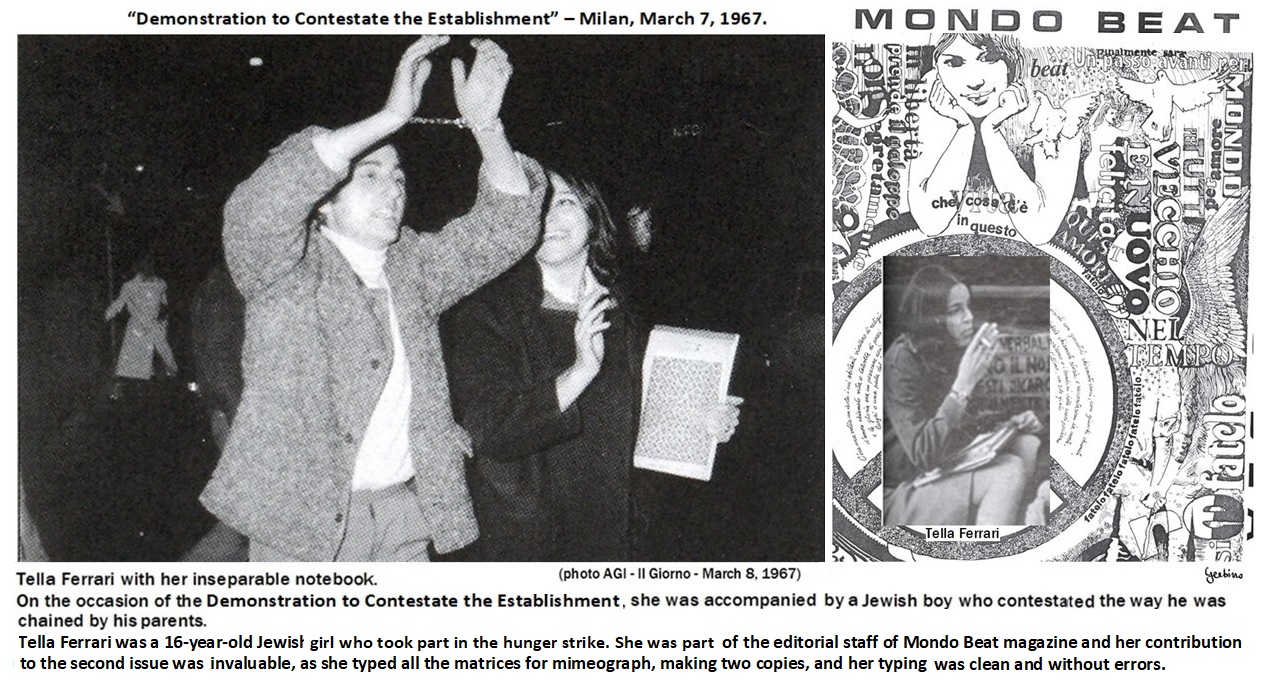
Demonstration to Contestate the Establishment - Tella Ferrari
Tella Ferrari was a 16-year-old Jewish girl who took part in the hunger strike. She was part of the editorial team of Mondo Beat magazine and her contribution to the preparation of the second issue was invaluable, since she typed all the matrices for the mimeograph machine, making two copies, and her typing was clean and without errors.
On the occasion of this demonstration, she was accompanied by a Jewish boy who proceeded in chains, to contestate his parents and teachers.
----------------
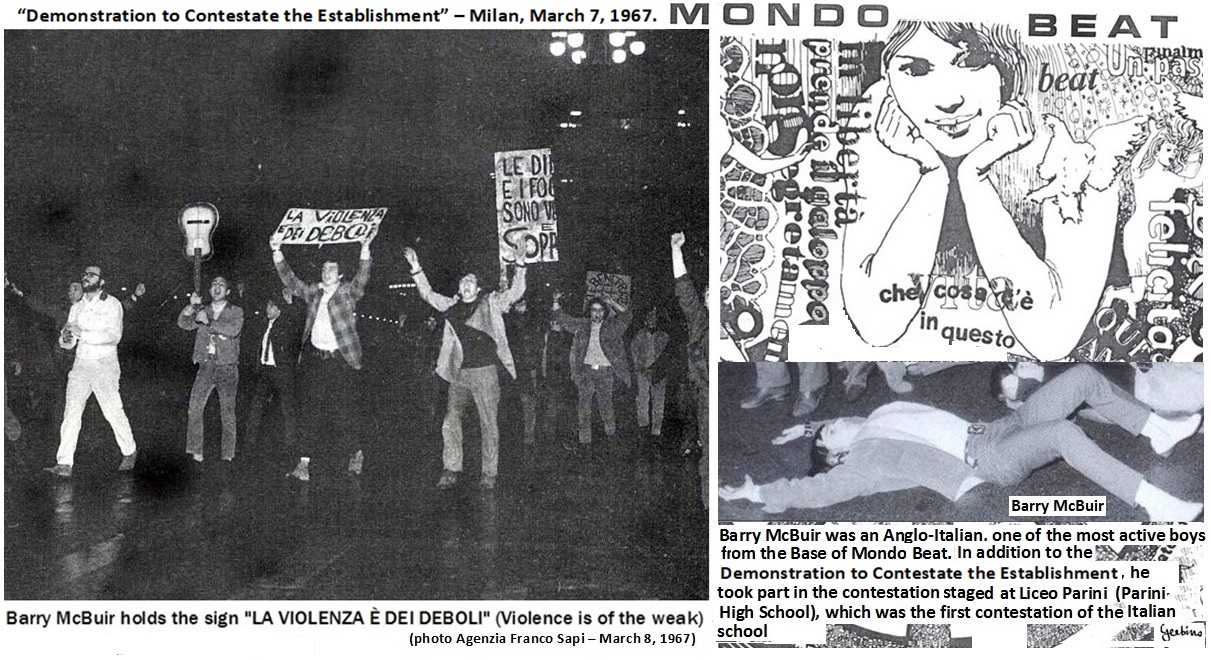
Demonstration to Contestate the Establishment - Barry McBuir.
In this photo, Barry MacBuir is the one holding LA VIOLENZA È DEI DEBOLI sign (Violence is of the weak).
He was an Anglo-Italian, one of the most active guys in the Base of Mondo Beat. In addition to the Demonstration to Contestate the Establishment, Barry MacBuir took part in the contestation staged at the Liceo Parini (Parini High School), which was the first contestation of the Italian school.
In this same photo, dressed in white, Andrea Valcarenghi.
----------------
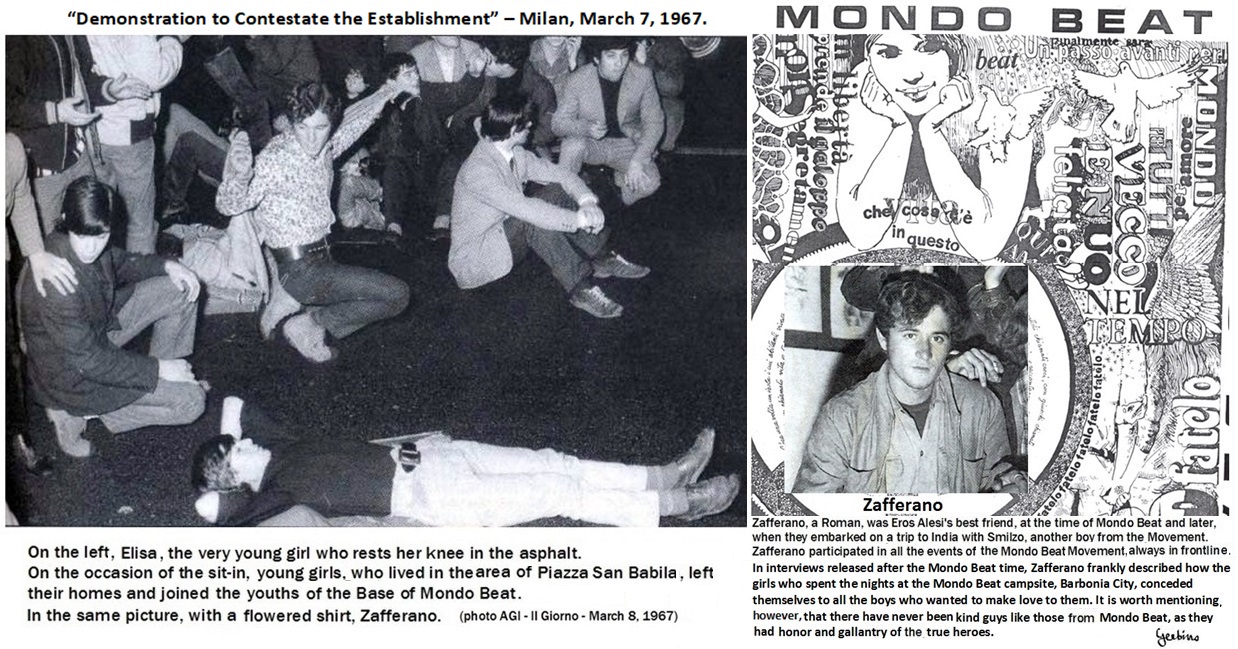
Demonstration to Contestate the Establishment - Zafferano wearing a floral shirt.
Zafferano, a Roman, was Eros Alesi Pasticca best friend at the time of Mondo Bet and later, when they embarked on a trip to India together with Smilzo, another boy from the Movement.
Zafferano participated in all the events of the Mondo Beat Movement, always in the front line. In interviews released after the Mondo Beat time, Zafferano frankly described how the girls who stayed overnight at Barbonia City, the Mondo Beat campsite, conceded themselves to all the boys who wanted to make love to them. But it is worth mentioning that there have never been kind guys like those from Mondo Beat, as they had honor and gallantry of the true heroes.
----------------
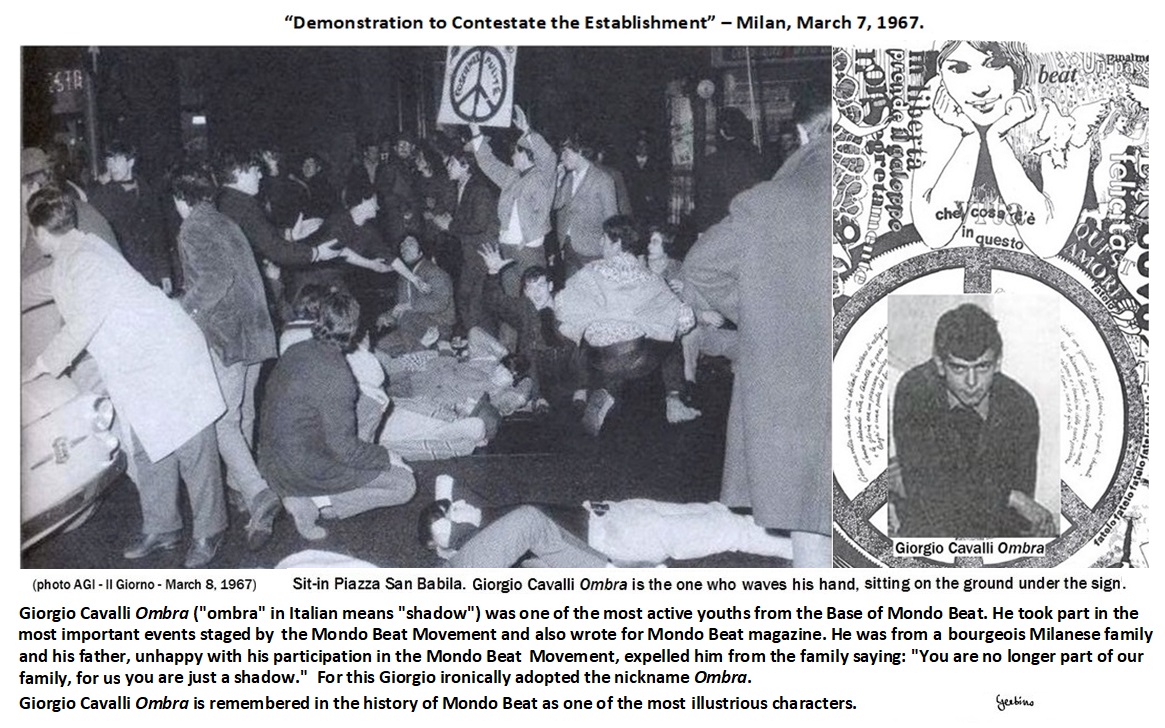
Demonstration to Contestate the Establishment - Giorgio Cavalli Ombra
In this photo, Giorgio Cavalli Ombra is sitting under the sign, making a gesture with his open hand.
He was from a bourgeois Milanese family and his father, unhappy with his participation in the Mondo Beat Movement, expelled him from the family saying: "You are no longer part of our family, for us you are just a shadow". For this reason Giorgio Cavalli ironically adopted the nickname "ombra", which in Italian is the equivalent of "shadow".
Giorgio Cavalli Ombra is remembered in the history of Mondo Beat as one of the most illustrious characters, as he took part in the most important events staged by the Mondo Beat Movement and also wrote for Mondo Beat magazine.
Here is the link to see him during a meeting of the editorial staff of Mondo Beat magazine.
Giorgio Cavalli Ombra
is the first sitting on the right.
----------------
Among the 200 youths who took part in the Demonstration to Contestate the Establishment there was also Angelo Bianco
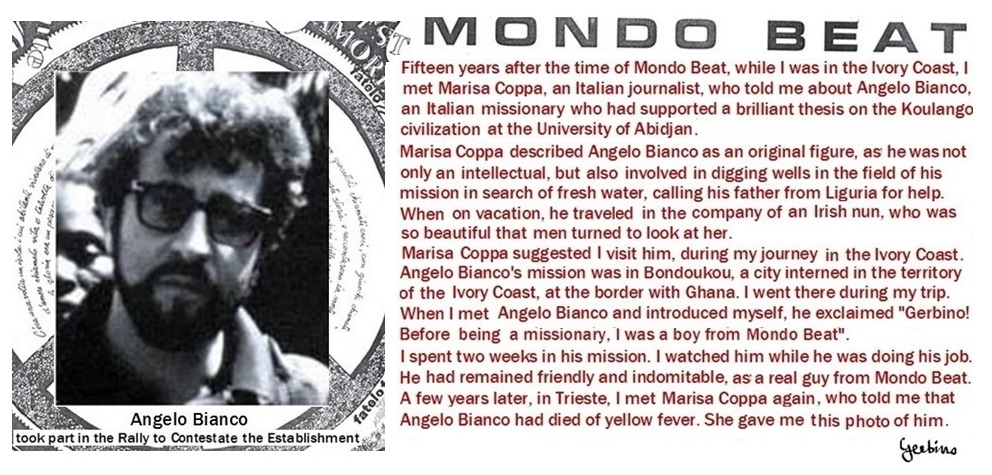
Angelo Bianco, of Mondo Beat, who was later a Comboni missionary in the Ivory Coast.
----------------
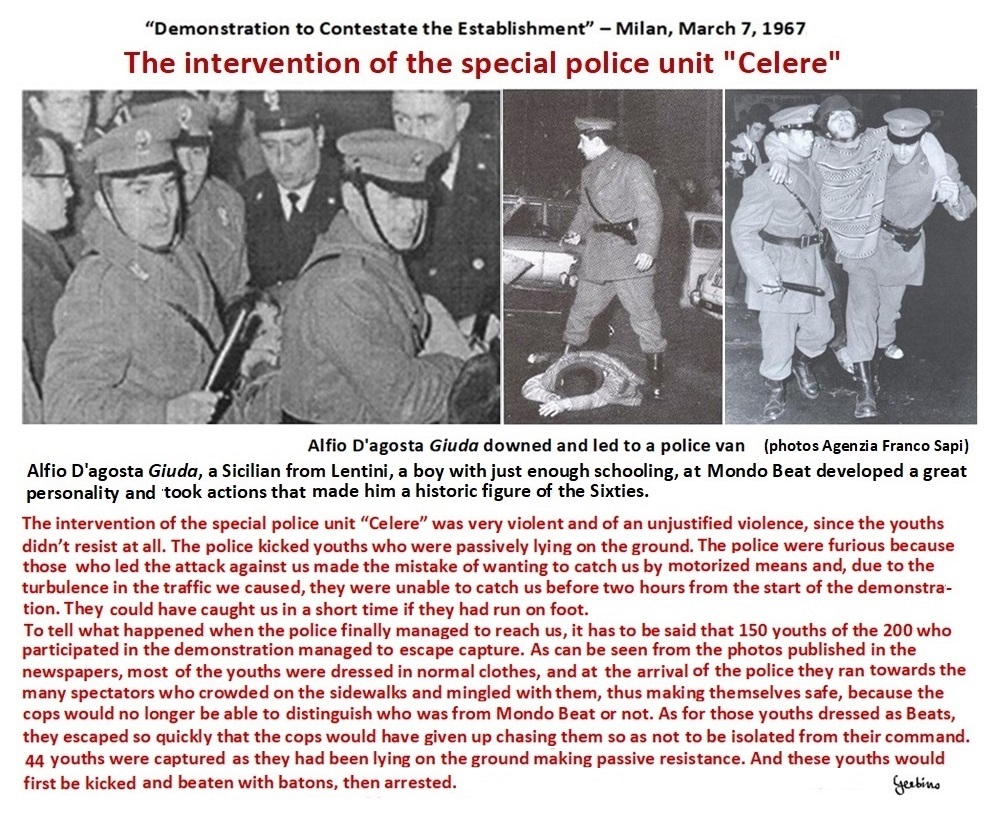
Demonstration to Contestate the Establishment - The intervention of the special police unit "Celere".
In the pictures, Alfio D'Agosta Giuda downed and led to a police van. He was a Sicilian from Lentini, a boy with just enough schooling. At Mondo Beat he developed a great personality and took actions that would make him a historical figure of the Sixties.
The intervention of the special police unit "Celere" was very violent and of an unjustified violence, since the youths didn't resist at all. The police kicked youths who were passively lying on the ground. The police were furious because those who carried out the attack against us made the mistake of wanting to catch us with motorized means and, due to the traffic turbulence we caused, they were unable to catch us before two hours from the start of the demonstration. They could have reached us in less time if they had run towards us on foot.
To tell what happened when the police finally managed to reach us, it has to be said that 150 youths of the 200 who participated in the demonstration managed to escape capture. As can be seen from the photos published in the newspapers, most of the youths were dressed in normal clothes, and when the police arrived they ran towards the many spectators who were crowding on the sidewalks and mingled with them, thus making themselves safe, because the police would no longer be able to distinguish who was from Mondo Beat and who was not. As for those boys dressed as Beats, many of them fled so quickly that the cops would have given up chasing them so as not to be isolated from their command. 44 young people were captured while lying on the ground offering passive resistance. And these young people were first kicked and beaten with truncheons, then arrested.
----------------
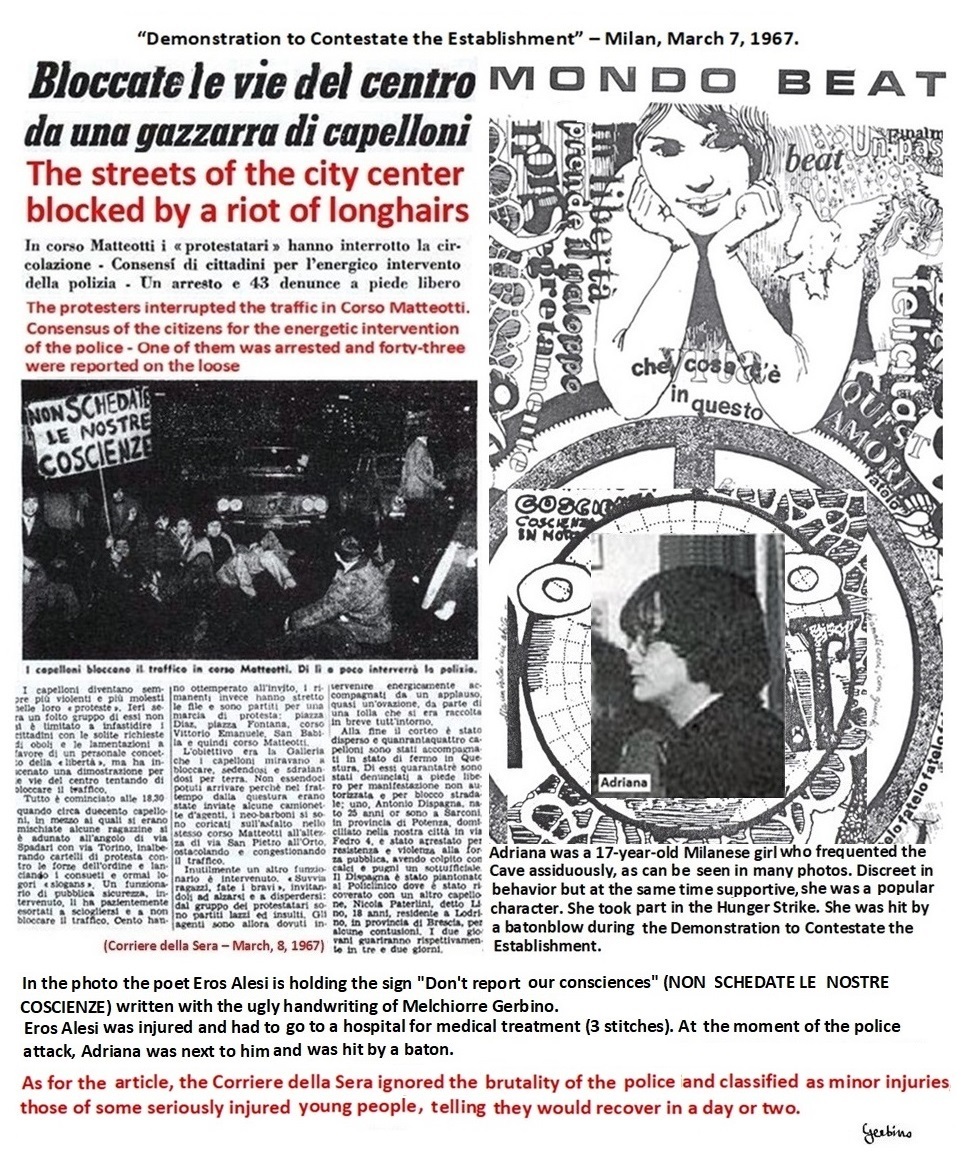
Demonstration to Contestate the Establishment - Eros Alesi and Adriana.
In the photo Eros Alesi Pasticca is holding the sign NON SCHEDATE LE NOSTRE COSCIENZE (Don't report our consciences) written in the ugly handwriting of Melchiorre Gerbino.
As for the content of the article, Corriere della Sera ignored police brutality and classified those of some seriously injured young people as minor injuries, saying they would recover in a day or two.
Eros Alesi himself was injured by the police and had to be admitted to hospital for medical treatment (3 stitches).
Adriana, a 17-year-old girl from Milan, was hit by a truncheon. A popular figure in the Base of Mondo Beat, Adriana had taken part in the hunger strike.
Here, we can see Adriana and Ercolino in front of a window of the Cave, where a poster is shown, which reads "You cannot kill an idea with a baton blow or a mandatory expulsion order"
(CON UNA MANGANELLATA O UN FOGLIO DI VIA NON SI UCCIDE UN'IDEA).
----------------

Demonstration to Contestate the Establishment - Cristo di Monza.
In the photo, Daniele is standing, Cristo di Monza is half lying on the ground.
Cristo di Monza (Christ of Monza), whose real name no one knew, attended Mondo Beat from beginning to end. He took part in all the events organized by the Movement. Shy in character, so much so that he sometimes seemed hostile, in reality he was supportive and kind. He was one of the bravest guys at the Base of Mondo Beat.
To say about this article, the Corriere d'informazione, which published it, was a newspaper of the same editorial group as the Corriere della Sera, i.e. the Crespi Group, which was the most powerful editorial group in Italy and the most reactionary. In the strategy of giving a negative image of Mondo Beat, the Corriere d'informazione would not have directly attacked Mondo Beat, but would have misrepresented the facts here and there. In this article the demonstration was described as a joyful walk of young people who intended to reach the Gallery in Piazza Duomo, but were prevented by the police because they caused traffic disturbances.
----------------
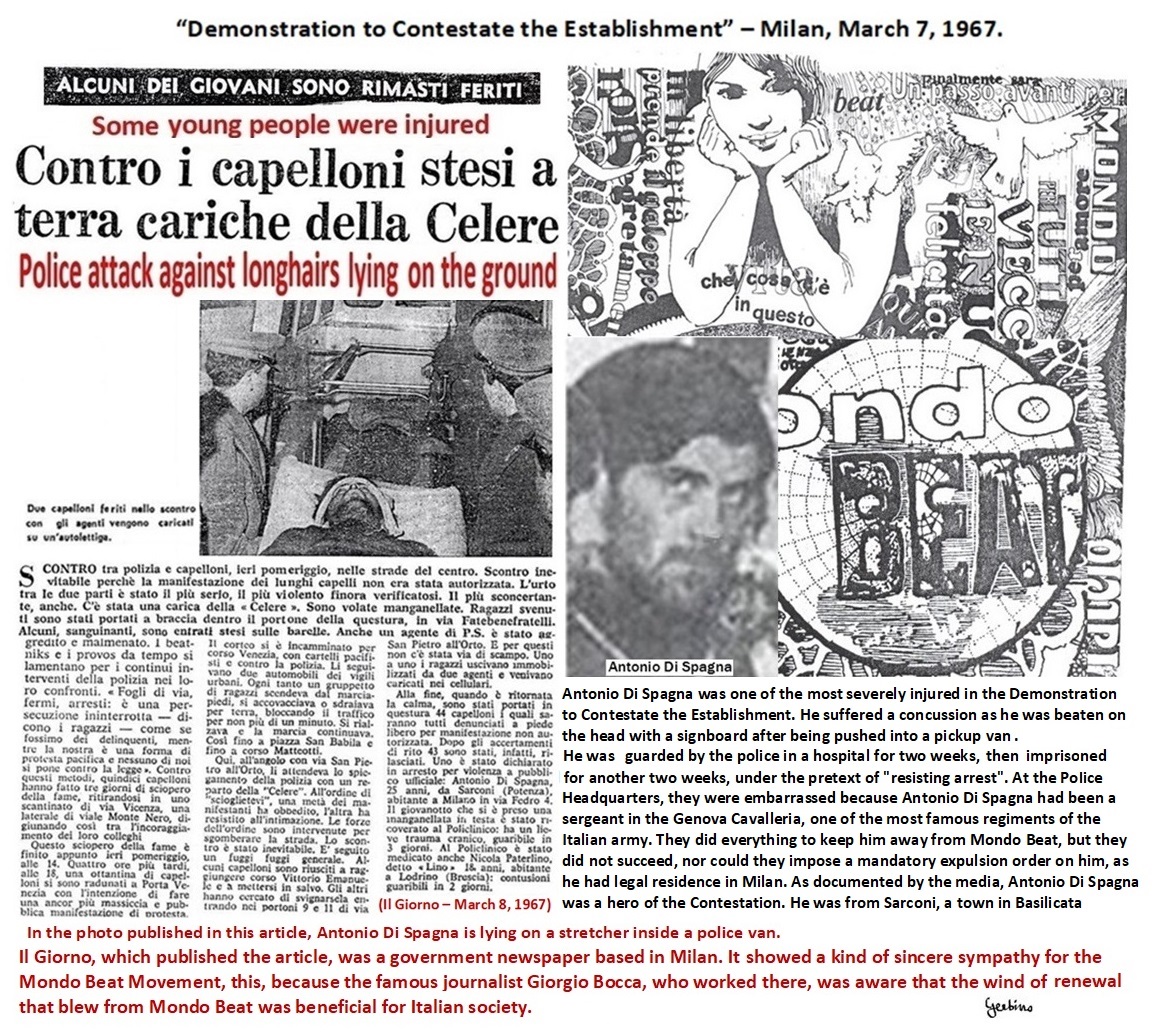
Demonstration to Contestate the Establishment - Antonio Di Spagna Papà.
Antonio Di Spagna Papà was one of the most severely injured in the Demonstration to Contestate the Establishment. He suffered a concussion as he was beaten on the head with a signboard after being pushed into a pickup van. He was guarded by the police in a hospital for two weeks, after which he was imprisoned for another two weeks, under the pretext of "resisting arrest". At the Police Headquarters, they were embarrassed because Antonio Di Spagna had been a sergeant in the Genova Cavalleria, one of the most famous regiments of the Italian army. They did everything to keep him away from Mondo Beat, but they did not succeed, nor could they impose a mandatory expulsion order on him, as he had legal residence in Milan. In the photo published in the article reproduced above, Antonio Di Spagna Papà is lying on a stretcher inside a police van. As documented by the media, he was a hero of the Contestation. He was from Sarconi, a town in Basilicata.
The newspaper Il Giorno, which published the article, was a government newspaper based in Milan. It showed a sort of sincere sympathy for the Mondo Beat Movement, this was because the famous journalist Giorgio Bocca, who worked at Il Giorno, was aware that the wind of renewal blowing from Mondo Beat was beneficial for Italian society.
----------------
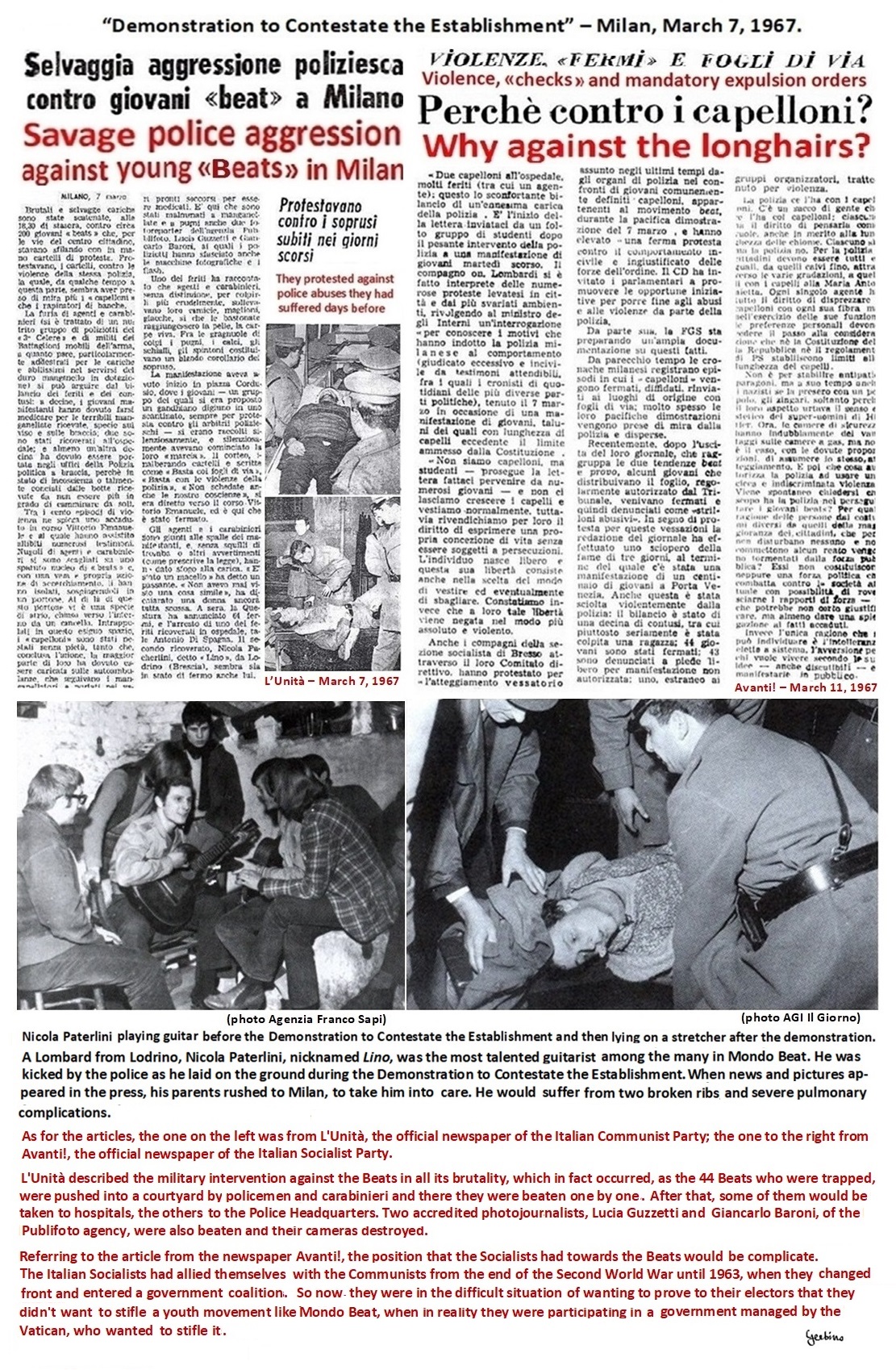
Demonstration to Contestate the Establishment - Nicola Paterlini Lino.
A Lombard from Lodrino, Nicola Paterlini, nicknamed Lino, was the most talented guitarist among many at Mondo Beat. He was kicked by the police as he laid on the ground during the Demonstration to Contestate the Establishment. When news and pictures appeared in the press, his parents rushed to Milan, to take him in care. He would have suffered not only from two broken ribs, but also from severe pulmonary complications.
As for the articles published above, the one on the left was from L'Unità, the official newspaper of the Italian Communist Party; the one to the right from Avanti!, the official newspaper of the Italian Socialist Party.
L'Unità described the military intervention against the Beats in all its brutality, which in fact occurred, as the 44 Beats who were trapped, were pushed into a courtyard by policemen and carabinieri and there they were beaten to blood, one by one, until they lost consciousness. After that, some of them would be taken to hospitals, the others directly to the Police Headquarters. Two accredited photojournalists, Lucia Guzzetti and Giancarlo Baroni, of the Publifoto agency, were also beaten and their cameras destroyed.
As for the article from the newspaper Avanti!, the position that the socialists would have had towards the Beats would have proved complicated. In fact, the Italian socialists, who had allied themselves with the communists since the end of the Second World War, had recently changed sides by entering a government coalition with the Christian Democrats. Now they therefore found themselves in a difficult situation, because they wanted to demonstrate to their voters that they did not want to stifle a youth movement like Mondo Beat, when in reality they were participating in a government run by the Vatican, which wanted to stifle Mondo Beat.
----------------
Two articles by Guido Boursier, of the Gazzetta del Popolo, Turin
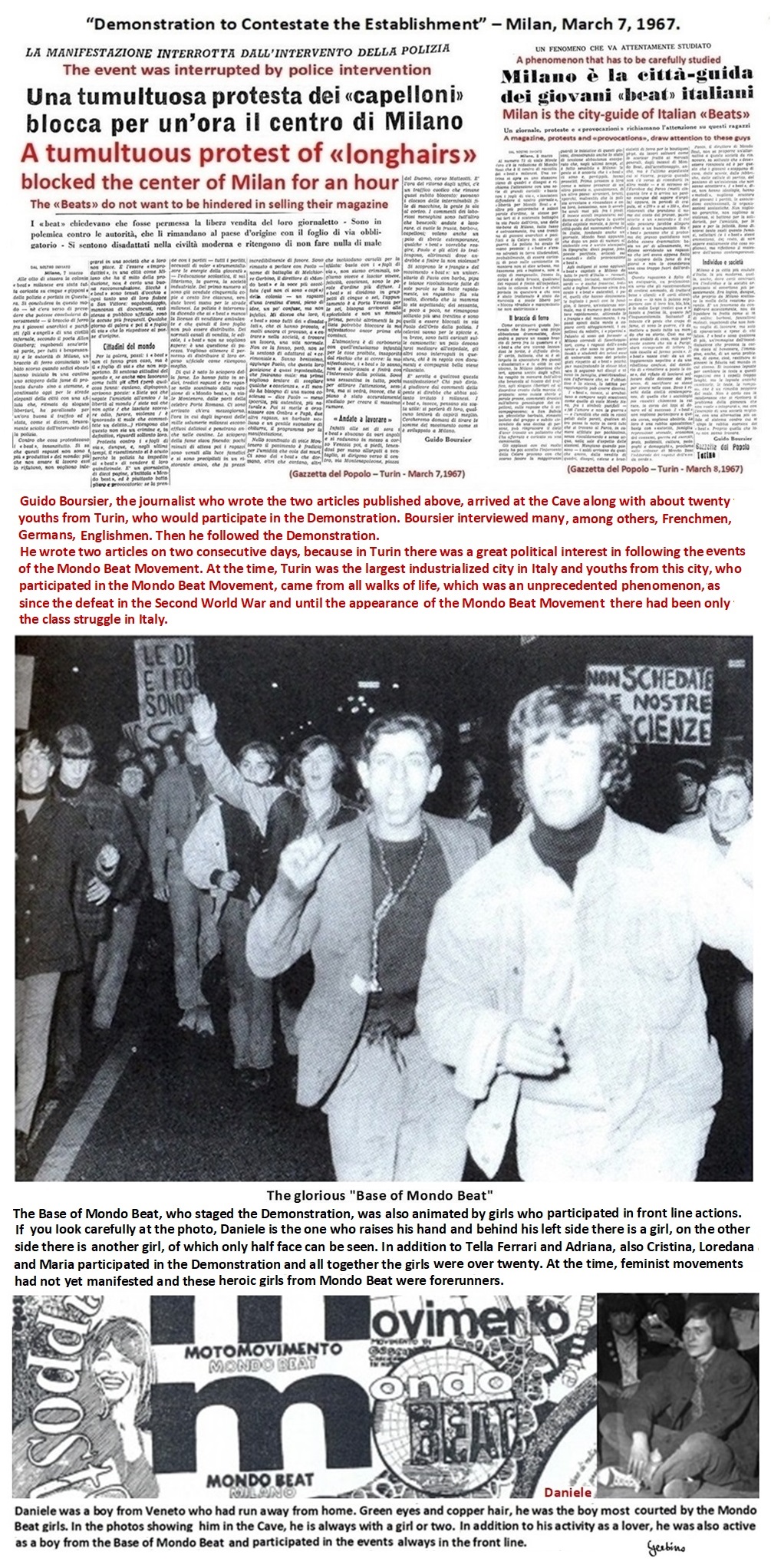
Demonstration to Contestate the Establishment - The glorious "Base of Mondo Beat".
Guido Boursier, the journalist author of the two articles published above, arrived at the Cave together with around twenty young people from Turin, who had come to take part in the demonstration. Boursier interviewed many young people in the Cave, including French, Germans, English. Then he followed the demonstration along its entire route.
Guido Boursier wrote two articles in two consecutive days because in Turin there was great political interest in following the events of the Mondo Beat Movement. At the time Turin was the most industrialized city in Italy and the young people of this city, who participated in the Mondo Beat Movement, came from all walks of life, which was an unprecedented phenomenon, since in Italy there had only been the class struggle from the defeat in the Second World War until the appearance of the Mondo Beat Movement.
----------------
The Base of Mondo Beat was animated by girls who also participated in front-line actions. In fact, if you look at the photo published above, it is Daniele who raises his hand, and behind him to the left there is a girl, on the other side there is another girl, only half of whose face can be seen.
Cristina, Maria, Loredana were among the girls who took part in the Demonstration to Contestate the Establishment
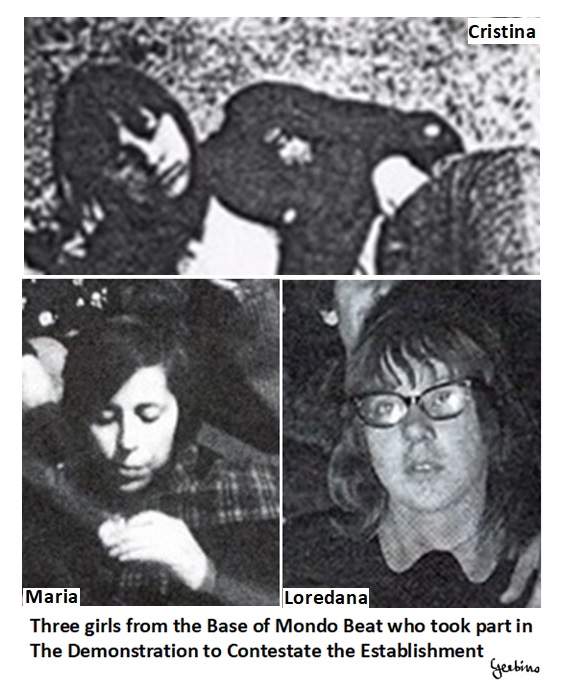
Cristina, Loredana, Maria, from the Base of Mondo Beat.
In total over twenty girls participated in the Demonstration to Contestate the Establishment. At the time, feminist movements had not yet manifested themselves and these heroic girls from Mondo Beat were their forerunners.
As for Daniele, he was a Venetian boy who ran away from home. Green eyes and auburn hair, he was the boy most courted by the girls who frequented the Cave, in whose photos he is always with one or two of them. Daniele was also active in the events organized by the Base of Mondo Beat, always participating on the front line.
Here is a link to see
Daniele and Adriana
in the cellar of the Cave.
Individual contestations
The day after the Demonstration, only a few youths came to the Cave. Many were still shocked by the previous day's police attack. But that day two young lawyers came to the Cave, Alessandro Garlatti and Carlo Invernizzi, who had their law firm not far from our premises. They said they would file a complaint against the Milan Police Headquarters for the illegal conduct it had towards the Beats, if we accepted their patronage. They didn't ask for money, they frankly said they were looking for notoriety. Before establishing their own law firm, they had practiced in that of the famous lawyer Francesco Carnelutti. We accepted their patronage.
On March 9th the comings and goings at the Cave normalized.
Of the approximately forty young people who were captured by the police during the demonstration (on that occasion Melchiorre Gerbino ran for a good kilometer to take refuge in a cinema in Piazza Cavour), all those who did not have legal residence in Milan, had received mandatory expulsion orders, thus, some had decided to leave the city, while others had decided to remain, to further contestate the establishment, even though they were aware they would end up in jail for a month, if caught again.
On March 10, at 8 am, six people left the Cave and headed for the Liceo Parini (Parini High School). Two of them, Alfio D'Agosta Giuda and Pierluigi Perronace Principe had already received a mandatory expulsion order. A third, a Frenchman, Albert Villy Augerau, had been repatriated to France, but had returned clandestinely to Italy. Of the other three, one was Ivan, an aristocrat of Russian descent, and the other two were Barry McBuir and Melchiorre Gerbino.
The six arrived at Liceo Parini a few moments before 8.30, the time when the bell would have rung to call the students. When the bell rang, the six went up the stairs and formed a human cordon between two columns, to block access to the institute.
Then Melchiorre Gerbino shouted to the students: "Don't tell us you're dying of the wish to be tortured by the math teacher, a fifty-year-old virgin lady with a mustache!".
At that, a young priest made his way among the students - "Enough! - he said - We want to get inside, otherwise we will roll up our sleeves! " - and he rolled up a sleeve of his cassock. At that, Barry McBuir raised a knee against the genitals of that priest, who bowed and withdrew.
But at that point the principal of the institute began shouting from a window on the front of the building.
"You! - shouted Melchiorre Gerbino to the principal - Try to be more serious and responsible! Don't let these young people become gullible like those of your generation!".
The contestation lasted until we heard the sirens of two police cars approaching, then we fled, while the principal, who had gone mad, made vulgar gestures from the window.
Such a contestation was unprecedented, nor the 6 of us who staged it, had foreseen that hundreds of similar contestations would follow.
In the afternoon of the same day, many students from the Liceo Parini, which was the most aristocratic high school in Italy, came to visit us. To welcome them, we displayed a poster in a window of the Cave: STUDENTI, GRIDATELO DAI BANCHI! (Students, shout it from the school desks!)
The first contestation of the Italian school system.
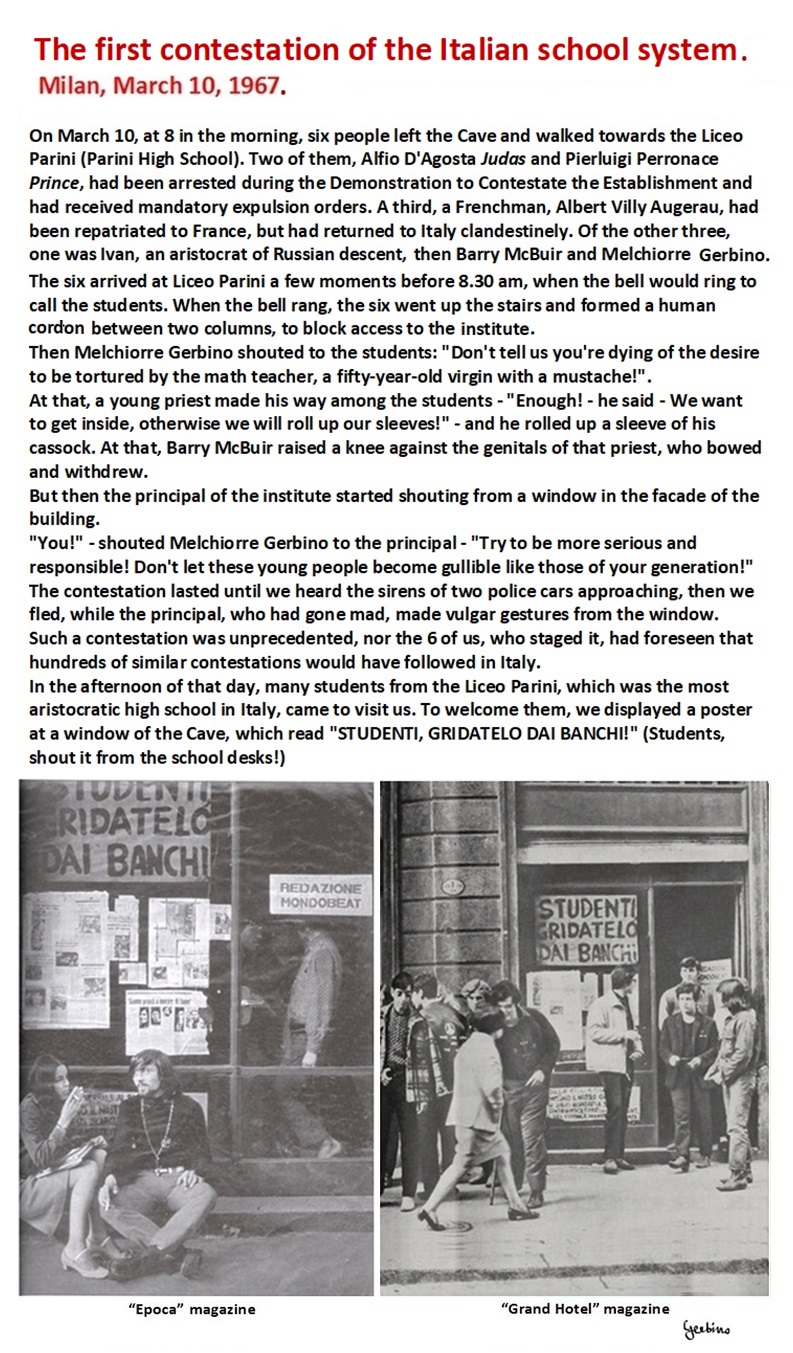
"STUDENTI, GRIDATELO DAI BANCHI!" (Students, shout it from the school desks!)
In the photo on the left, Tella Ferrari and Cristo di Monza.
----------------
On March 11, Alfio D'Agosta Giuda, who had participated in the Demonstration to Contestate the Establishment and was one of the 6 who had contestated the Italian school system at Liceo Parini, told Melchiorre Gerbino that he was determined to commit to new actions, although he was aware that he would be imprisoned, since he had already received a mandatory expulsion order. So the two have considered how to stage a spectacular action.
They decided to paste the document of the mandatory expulsion order on a sign and write on it "Stay away from me! I am dangerous! The Police Headquarters has sanctioned my awareness of a free man" (Allontanatevi! Sono un pericolo! La Questura ha diffidato la mia coscienza di uomo libero).
When the sign was ready, Melchiorre Gerbino phoned two photojournalists from Agenzia Publifoto and, upon their arrival, Alfio D'Agosta Giuda left the Cave to head towards Piazza Duomo, to perform the most exemplary action in the history of the Mondo Beat Movement.
He was arrested and taken at the Police Headquarters, but they did not dare to put him in jail, as the news of his action was covered internationally.
They sent him by plane to Sicily, to his parents, but it didn't take long for Alfio D'Agosta to return to Mondo Beat.
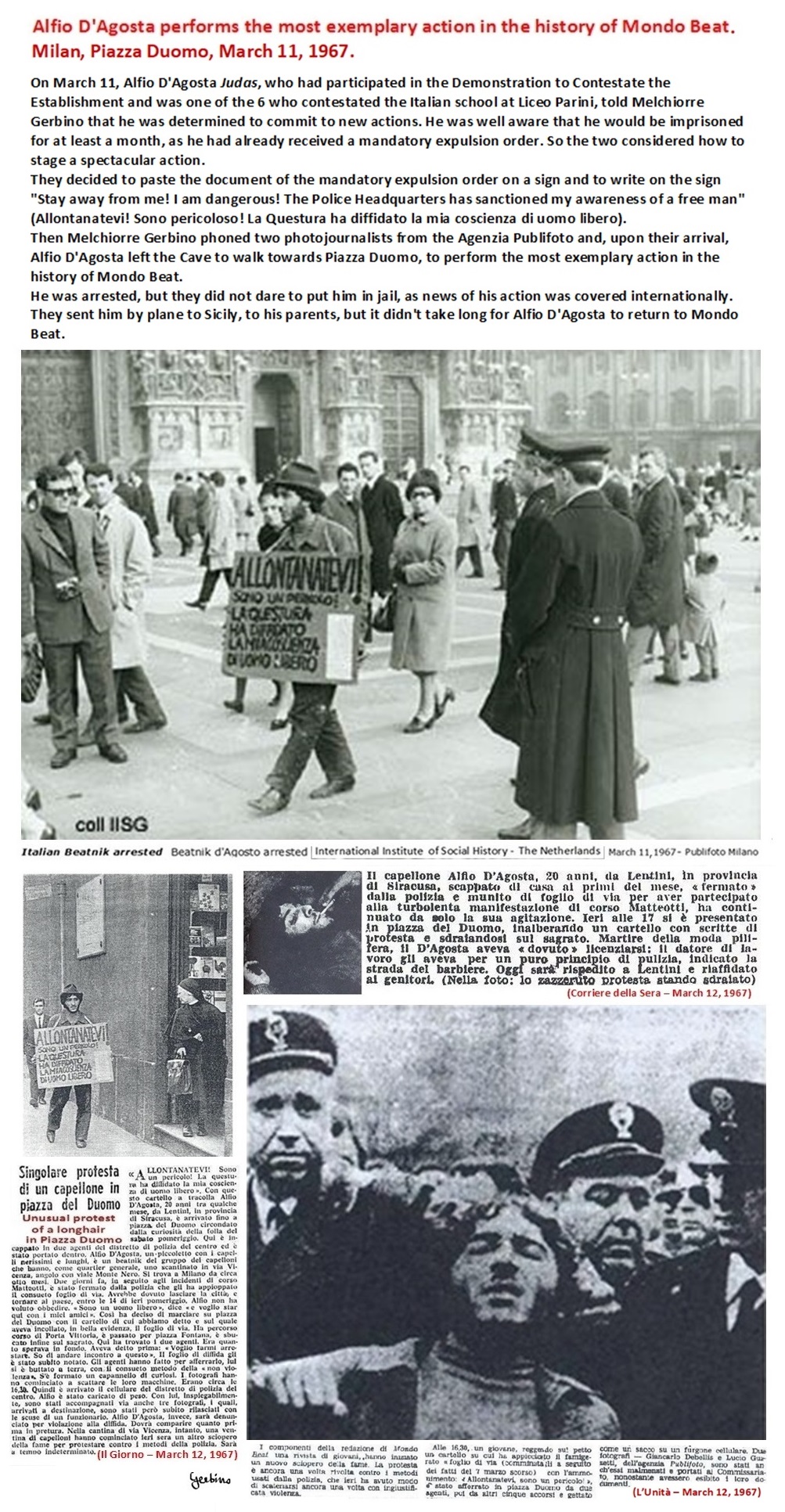
Alfio D'Agosta Giuda performing the most exemplary action in the history of Mondo Beat.
----------------
On March 12, in Piazza Duomo, Eros Alesi Pasticca, Ronny, Morgan and Cristo di Monza contestated the Police Headquarters. They hadn't received any mandatory expulsion order, since they had residence in Milan, however they could end up in jail on the pretext of "resisting the police". The photos reproduced below are the funniest from the history of the Mondo Beat Movement. Look at the faces of those who could have ended up in jail and the faces of the police. You had to have great courage to carry out actions like these, because when you were taken to the Milan Police Headquarters there were no tarallucci e vino.

Eros Alesi Pasticca, Morgan, Cristo di Monza and Ronny contestating the Milan Police Headquarters.
No one knew Ronny's real name. He was not assiduous at Mondo Beat, he often appeared and disappeared. As you can see, he was a very original boy. Before organizing this contestation together with Eros Alesi Pasticca, Cristo di Monza and Morgan, he had participated with them in the Demonstration to Contestate the Establishment.
----------------
On March 16 we learned from the newspapers that Albert Villy Augerau had been arrested and sent to prison.
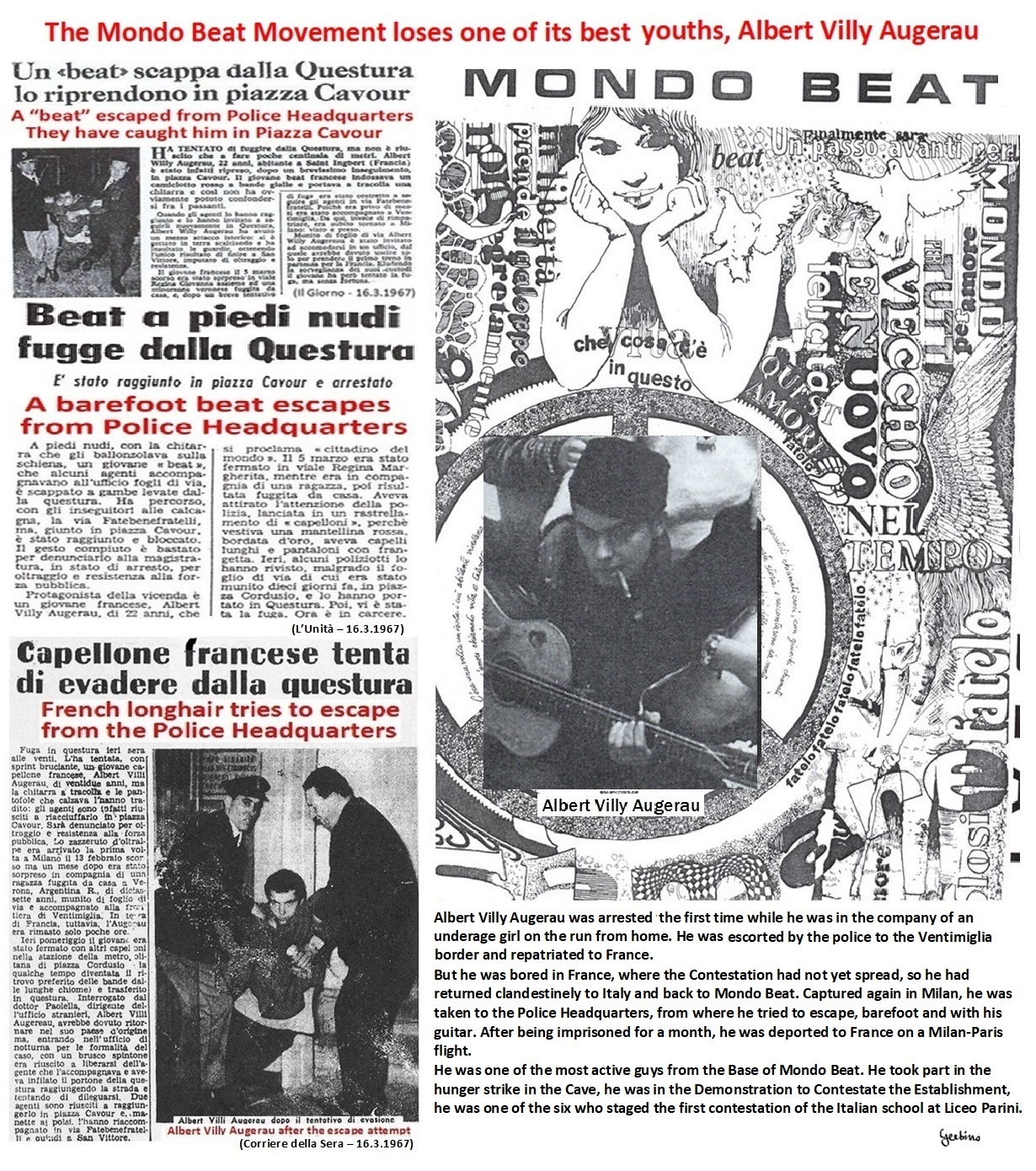
The Mondo Beat Movement loses Albert Villy Augerau, one of its best youths.
Albert Villy Augerau was arrested, for the first time, while he was in the company of a minor girl from Verona who had run away from home. Then he was escorted by the police to the Ventimiglia border and repatriated to France.
But he was bored in France, where the Contestation had not yet spread, so he had illegally returned to Italy and back to Mondo Beat. Captured again in Milan, he was taken to the Police Headquarters, from where he tried to escape, barefoot and with his guitar. After being imprisoned for a month, he was allegedly deported to France on a Milan-Paris flight.
Albert Villy Augerau was one of the most active guys from the Base of Mondo Beat. He took part in the hunger strike in the Cave, he was in the Demonstration to Contestate the Establishment, he was one of the six who staged the contestation of the Italian school system at Parini High School.
----------------
This cycle of contestations, which lasted 2 weeks (Hunger strike; Demonstration to Contestate the Establishment; individual contestations), ended with a poster by Melchiorre Gerbino, displayed in a window of the Cave.
The poster reads: ARRIVI (Arrivals) PARTENZE (Departures). Under ARRIVI there are the names of the youths who arrived in Milan from different cities who had to leave, due to mandatory expulsion measures. Under PARTENZE there are the names of the youths who had to leave Milan, due to the same type of injunctions.
More below it reads: E LE STELLE STANNO A GUARDARE (And the stars look down) and the date March 17, 1967.
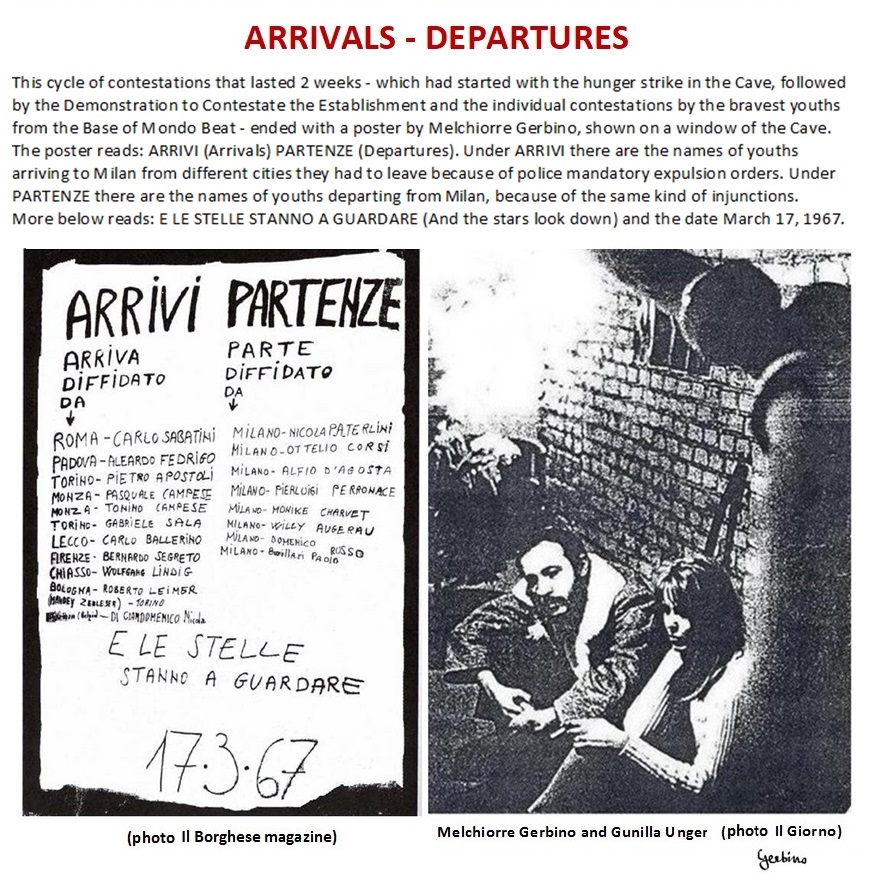
Picture on the left. Arrivals and Departures of Beats subjected to mandatory expulsion orders.
Picture on the right. Gunilla Unger and Melchiorre Gerbino in the cellar of the Cave.





























